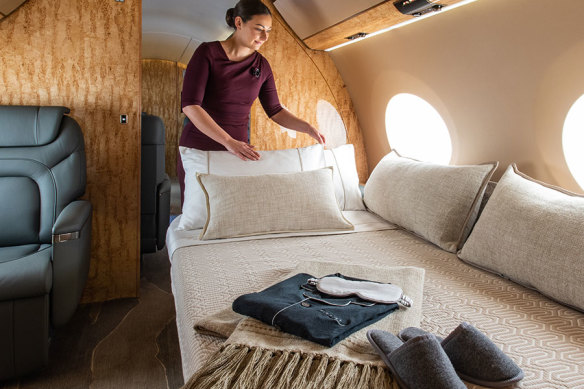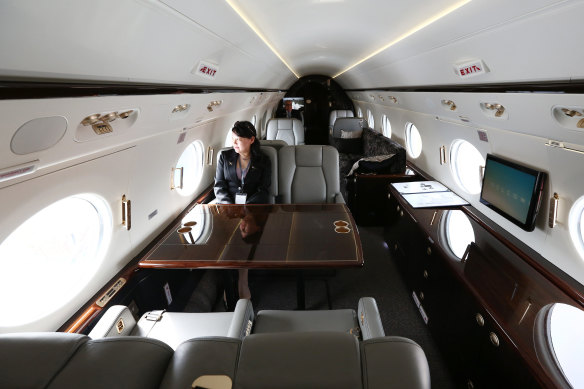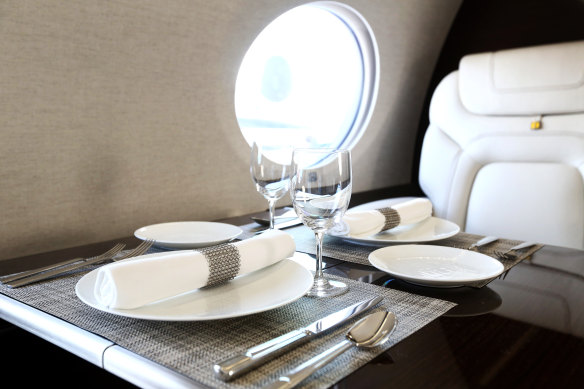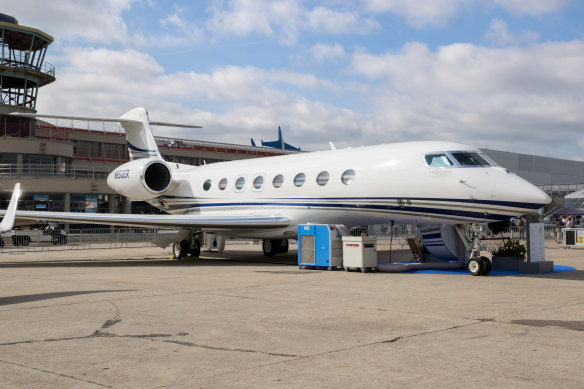What I learnt when I trained to become a private jet attendant
By Hazel Plush
The pressure hadn’t reduced me to tears, but the lemon juice did. To stem the stinging, I rubbed my eye with the back of my hand – a hygiene disaster, no doubt – managing to smear mayonnaise on my forehead in the process.

Learning to look after the one per cent at Flexjet’s Red Label Academy.
In the tiny galley kitchen, its floorspace no bigger than a bathtub, I felt like a clumsy giant: my apron streaked with garlic purée, my fingers fumbling. Even without any turbulence, slicing the chicken had been tricky enough. As if on cue, an acrid waft escaped from the oven. My sourdough croutons were burning.
At 40,000 feet, even making a simple Caesar salad requires military-grade planning and dainty choreography. At home, I’ll whirl through the kitchen leaving a trail of dirty plates and discarded ingredients – but in the galley of a $US78 million ($A117 million) Gulfstream G650, considerably more finesse is required.
“Remember the presentation: don’t pile everything on, a little white space is appealing,” Francesco Vanerio advised diplomatically, as I eyed up the waiting dinner plate. For him, a veteran of five-star hospitality, such panache comes naturally, but I was just glad to have made something edible (to me, at least) with all of my fingers intact.
This is embarrassing to admit, but we weren’t even airborne, and nor were we in a real jet. No, I was merely in the test kitchens of Flexjet’s Red Label Academy, at Farnborough Airport, southwest of London – a new “finishing school” for private jet cabin attendants. Each kitchen is designed to the dimensions of a private jet’s galley, even down to its minuscule oven and microwave, which are both barely bigger than a shoebox. But to my relief – and no doubt Vanerio’s too – we were on terra firma, with no hungry passengers waiting.

The interior of a Gulfstream private jet. Credit: Getty Images
Launching in November, the academy was devised by private aviation company Flexjet, whose 270-strong fleet of fixed-wing aircraft whisks ultra-high net worth individuals – the “one per cent” – all over the globe. Here, the world’s finest cabin crew, all with extensive experience already, will further hone the skill of “five-star hospitality” in the skies, via masterclasses from experts in mixology, wine, floristry, sushi, emotional intelligence, body language and more.
The programme is led by Vanerio, Flexjet’s VP of Customer Experience, whose long career in luxury hospitality includes the Villa d’Este hotel in Lake Como – the legendary stomping ground of A-listers, the jet-set and modern-day royalty: the Clooneys, Obamas et al. A suave, softly-spoken figure in an immaculate suit, Vanerio won’t be drawn on his celebrity encounters – but given Flexjet’s calibre, it’s likely he’s served many high-profile passengers.
The company’s shared ownership business model means that its clients buy a share of the aircraft – typically a 16th – for which they are entitled to 50 hours of flying annually, at an additional cost. There are also monthly fixed and variable fees to cover crew, maintenance, insurance and fuel, and “Owners” (as Flexjet calls them) typically commit to a five-year contract. A Praetor 600 jet, for example, is valued at around $US20 million: to buy a 16th, you’ll need to pay around $US1.25 million – and to travel in it, an extra $US14,000 per hour.
Naturally, its Owners expect the utmost service, so Flexjet intends to put all of its 130-plus Cabin Servers through the Red Label Training Academy each year. Every course lasts a week, or a fortnight for new recruits – and one drizzly November day, I joined its inaugural classmates for a typical session. Yes, I was woefully out of my depth, but here’s what I learnt: from the “theatre” of inflight service, to the gadgets you should never fly without.

Flight attendants are expected to provide impressive, multi-course meals on board. Credit: Getty Images
Wherever they fly, every cabin server travels with a bag full of ingredients, from which they can whip up an impressive multi-course feast – just in case airport catering isn’t up to scratch.
“Not all catering services are equal,” said Megan Wolf, Flexjet’s Chief Experience Officer tactfully. “Paris, New York, London – they’re excellent. But in some other locations, the food that’s delivered simply doesn’t meet our standards, it could be delayed, or doesn’t turn up – so the servers have to think on their feet.”
I asked my classmates for their insider tips. “Scone mix and cookie dough are so useful,” said one. “Just add a little water and butter, pop them in the oven, and the aircraft smells of freshly-baked scones just as the Owners are boarding. With some cream and jam, you have afternoon tea – perfect.”
Another extolled the virtues of antipasti: “some fine cheeses, olives and charcuterie are so versatile,” he explained. “You can serve them in the traditional way, or think outside the box – by using them to top a gourmet Bloody Mary cocktail, perhaps.”
Each server works solo: unlike on commercial flights, they have no backup team, so must be confident enough to take the lead. “I always say, if you’re not comfortable hosting a dinner party for 10 discerning guests, this isn’t the job for you,” said Wolf.

The cost of operating a private jet can be $US14,000 per hour.Credit: iStock
The pace of private aviation is lightning fast, with servers hosting multiple clients in one day, and crossing time zones and continents in the blink of an eye. As such, they are encouraged to buy local delicacies from their departure points, in order to create bespoke in-flight meals. Mochi from Tokyo, parmesan from Emilia Romagna, caviar from Dubai. When not on shift (or “on rotation” in crew parlance), they’ll also stock up on supplies, advised Wolf: “the likes of Ocado and Instacart [the US equivalent] have been game-changers”.
If the client is amenable, the crew might also offer “social service” – preparing food or drink in front of the passengers, while engaging them in lively conversation. In action, it’s like watching an extraordinarily talented TV chef – a skill that, as my Caesar salad experience proved, is far harder than it looks. “It’s all about the theatre, the entertainment,” Vanerio mused. Occasionally, Flexjet might invite other hospitality experts on board: a sommelier, caviar connoisseur or a sushi chef perhaps, to offer an even more “elevated” experience.
As part of their training, Flexjet’s crew spend an all-expenses-paid night at London’s the Dorchester, a chance to enjoy five-star service from the “other” side. “Many of our cabin servers are from the US, where that heightened level of service doesn’t really exist,” explained Wolf. “It’s vital for them to understand it first-hand, so they can ensure the Owners experience a seamless lifestyle wherever they travel.”
Alas, I didn’t get to join the sleepover, but I did eavesdrop on their debriefing session. The group gathered around a conference table, watching videos that they’d each made to showcase their “emotional responses” to the Dorchester experience. On an interactive whiteboard, the lead trainer noted the buzzwords from their missives (“finesse”, “polished”, “personalised”, etc) – and discussed how to evoke them on-board.
“Reading the room is essential,” Vanerio explained, “through body language, eye contact, non-verbal communication. Does an Owner want you to engage and entertain them during the flight, or would they prefer to be left alone? If they’re deep in conversation, can you catch the eye of the lead Owner to offer them a refreshment? Doing that discreetly is an art form.”
As with groceries, Flexjet’s staff are encouraged to purchase thoughtful gifts for Owners – tailored perhaps to their destination, companions or hobbies. “It could be something as simple as a colouring book or travel games to keep their children entertained,” said Wolf, “or a pair of slippers to increase their comfort on board”. The point isn’t to shower clients with Birkin bags or Dom Perignon – rather, to give something from the heart.
Do clients ever have outlandish “riders”, or make demands of Flexjet that it can’t fulfil? “Quite the opposite,” Wolf explained; “with their levels of wealth, they know they’re perhaps in the strongest position to “pull some strings” – though we’ll always do whatever we can to accommodate. On one occasion, we were flying a group of young men and they said they really wanted fresh burgers from a certain US chain – so when they transferred from their helicopter to the jet, I was there waiting with a bag, still hot. They were over the moon!”
Many requests are far simpler (“a particular flavour of sorbet, for example – and one Owner likes his chocolate bar broken up into seven pieces”), but others are too tricky to pull off. “If somebody wants to make a schedule change, airport slots are out of our hands. Altering flight timings is one of the toughest requests, and unfortunately it’s not always possible.”
At the end of the day, we relocated to one of Flexjet’s Praetor 600 aircraft to see the crew in action. From an area no bigger than a coat cupboard, our server presented a multi-layer afternoon tea platter, dainty sandwiches, a splash of soya for my English Breakfast blend – and lashings of champagne, naturally. Has an aircraft ever run out of bubbly? “Absolutely not,” laughed Wolf; “we always carry more than enough on board”.
Forget making salads: pouring wine is my forté, and I couldn’t resist the chance to give it a go. “Ensure the label is facing the Owner, pour slowly with a napkin to catch any spills, and explain the flavour profile of the champagne,” the server advised. Reader, I nailed it.
Of course, the in-flight is far more demanding: try pouring a glass for a guest that’s paying $US14,000 per hour, as you bounce across the Atlantic on your fourth flight of the day – while your croutons singe in the oven.
“It’s like being a swan,” said Vanerio; “you need to make it look effortless. It’s hard work, but what an incredible job. Each day is extraordinary – and I’d rather be standing up in a private jet than sitting in an economy seat.”
The Telegraph, London
Sign up for the Traveller newsletter
The latest travel news, tips and inspiration delivered to your inbox. Sign up now.